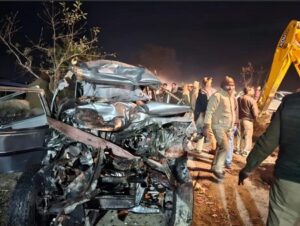Flight accident in Dubai
Emirates Flight 521 is a scheduled international passenger flight from Thiruvananthapuram, India, to Dubai, United Arab Emirates,[5] operated by Emirates using a Boeing 777-300.[6] On 3 August 2016, the aircraft carrying 282 passengers[7] and 18 crew[8] crashed while landing at Dubai International Airport, at approximately 12:45 local time.[9][10]
All 300 people on board survived the accident and were evacuated from the aircraft; 24 were injured.[4] An airport firefighter died during the rescue operation and another eight were injured.[4][3] This accident was the first hull loss of an aircraft operated by Emirates.[11]
Contents
1 Aircraft
2 Flight
3 Passengers and crew
4 Investigation
5 Aftermath
6 Notes
7 References
8 External links
Aircraft
The aircraft involved was a Boeing 777-31H[note 1] with the registration A6-EMW, serial number 32700, and line number 434. It was equipped with two Rolls-Royce Trent 892 engines and was thirteen years old, having made its first flight on 7 March 2003.[12] It was delivered new to Emirates on 28 March 2003, and had since logged 58169 flight hours in 13620 cycles.[13]
Flight
On 3 August 2016, Flight EK521 took off from Trivandrum International Airport (TRV) at 10:34 IST (05:04 UTC), 29 minutes after its scheduled departure time. It was scheduled to land at Dubai International Airport (DXB) at 12:24 GST (08:24 UTC).[14]
The approach and landing were normal from the air traffic control (ATC) point of view, with no emergency declared according to ATC recordings at the time.[15][16] The crew reported that they were going around, after which the tower instructed them to climb to 4,000 feet, which was acknowledged by the crew. Shortly after, the tower instructed the next flight to go around and alerted emergency services.[15] Wind shear and an ambient temperature of 48 °C (118 °F) were reported.[12]
The accident occurred at 12:37 Gulf Standard Time (08:37 UTC). According to the Preliminary Accident Report,[4] significant wind shear was impacting on the aircraft’s airspeed through late final approach, and the aircraft touched down onto the 4,000 metres (13,000 ft) long runway 12L at a point approximately 1,100 metres (3,600 ft) beyond the upwind threshold, at a speed of 162 kts. Two seconds later, the cockpit RAAS issued a “LONG LANDING” [note 2][17] warning and the crew initiated a go-around. Six seconds after main-wheel touchdown, and with the nose-wheel still off the runway, the aircraft became airborne again after rotating to climb attitude. Four seconds later the flap setting was reduced to 20°, followed by the undercarriage being selected to retract. Engine throttle settings appear to have remained unchanged during this period. The aircraft attained a maximum height above the runway of 85′ with its indicated airspeed decreasing, before commencing to settle back towards the ground. Twelve seconds after becoming airborne the throttles were advanced to maximum, however the aircraft continued to sink and it impacted the runway with its undercarriage in a partially retracted state three seconds later.
The aircraft first impacted with the underside of its rear fuselage and skidded about 800 metres (2,600 ft) along runway 12L with its landing gear partly retracted as it rotated to the right about 120 degrees.[4] As the aircraft skidded down the runway, the number 2 (starboard) engine detached and slid along the wing’s leading edge toward the wingtip.[4] Firefighting appliances were at the aircraft less than 90 seconds after it came to rest (which was 33 seconds after the initial impact) and started to fight fires at several locations as all 300 passengers and crew were safely evacuated.[4][18] Video from inside the aircraft, taken on passengers’ cellphone cameras, showed the passengers failing to evacuate, instead giving priority to carry-on luggage, resulting in an overly long evacuation and heavy criticism.[19] Nine minutes after the aircraft came to a stop, with only the aircraft captain and the senior flight attendant still on board (checking for any remaining passengers), there was a large explosion. The explosion, of the aircraft’s center fuel tank, resulted in the death of a firefighter, a Ras al-Khaimah resident named Jasim Issa Mohammed Hasan.[4][20] Twenty-four of the aircraft’s occupants were injured – including the captain and the senior flight attendant, who evacuated after the explosion; the senior flight attendant was the only person among the passengers and crew seriously injured, suffering from smoke inhalation.[4][15] In addition, eight firefighters and a policeman were injured, several of the firefighters suffering from heat stroke.[4][21] The explosion resulted in the fire spreading to the aircraft’s cabin; it took firefighters 16 hours to bring the fire under control.[4] The airport was closed during and following the accident, which resulted in many diverted flights.[22



